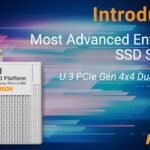
Seagate and Phison have often worked together. This is also the case with the new enterprise SSDs from the Seagate Nytro 5350 and 5550 series. The 2.5-inch SSDs with U.2/U.3 are based on the simultaneously presented Phison X1 SSD platform with PCIe 4.0. This promises a lot of performance and a high return.
The controller manufacturer Phison is best known for its SSD platforms for customers. But the company also wants to play in the enterprise segment and has now presented the new “X1 SSD” platform, which other manufacturers can use for their own products for a fee.
The first customer and development partner at the same time is Seagate with new enterprise SSDs from the Nytro family. The X1 platform uses Phison’s E20 controller (PS5020-E20), for which there were several hints beforehand. Phison now only speaks of the “X1 SSD Solution” and only casually mentions the actual controller name.
Core data on the Phison X1 SSD platform (Photo: Phison) According to Phison, two ARM R5 cores and “dozens” of small co-processors are used. The latter should ensure high energy efficiency. The interface is PCIe 4.0 x4 in a two-port design. In the 2.5-inch format with a height of 7 mm or 15 mm, the U.3 connection is used and 128-layer 3D NAND with 3 bits per cell (TLC) is chosen as the flash memory.
We’re talking about “eTLC”, which stands for select enterprise-class TLC-NAND. At its peak, this platform would deliver high transfer rates of up to 7,400/7,200 MB/s in sequential read/write, thus using almost the practical limit of the interface.
The 1,750,000 IOPS possible at the top when randomly reading 4K data is particularly high for a PCIe 4.0 SSD. A maximum of 470,000 IOPS are stated in writing. Phison draws a comparison, boasting that it is faster than competitors such as the Samsung PM1733, the Kioxia CM6, the SK Hynix PE8010, or the Intel P5510 in both sequential and random transfers. The advantage is especially great with sequential writing. Only independent tests will show how much of it remains in practice.
Phison X1: Performance comparison according to the manufacturer (Photo: Phison) It should also be noted that Phison makes a comparison here with models that have usually been on the market for a few years. For example, the platform couldn’t compete with a brand new Kioxia CM7 with 14 GB/s over PCIe 5.0.
Phison X1: Advantages in terms of power consumption according to the manufacturer (Photo: Phison) Also in terms of power consumption and thus in combination with the performance per watt, Phison is ahead of the competition with the X1 SSD platform. The SSDs would require 6.5 watts at idle, 13.5 watts for random reading, and 17.9 watts for random writing. The further details: product pages and the Datasheet (PDF).
Not much needs to be said about the new Seagate SSDs of the Nytro 5350 and Nytro 5550 series, as they use the platform described above with a different logo. The 5350 series is designed for read-intensive, write-light workloads (1 DWPD), while the 5550 series is designed for mixed workloads (3 DWPD).
The range is from 1.92 TB to 7.68 TB for the 5350 series and from 1.6 TB to 6.4 TB for the 5550 series with more spare storage at the cost of less usable capacity.
The top 15.36 TB and 12.8 TB models that have also been announced are not yet in the Datasheets (PDF) deposited. The smaller models should be available to business customers this month. Prices were not communicated.
RS News or Research Snipers focuses on technology news with a special focus on mobile technology, tech companies, and the latest trends in the technology industry. RS news has vast experience in covering the latest stories in technology.